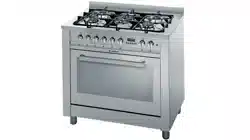Loading ...
Loading ...
Loading ...

11
Electrical connection
THE APPLIANCE MUST BE EARTHED
The appliance is designed to work with alternating current
at the supply voltage and frequency indicated on the rating
plate (situated on the rear part of the appliance and on the
last page of the instruction manual). Make sure that the local
supply voltage corresponds to the voltage indicated on the
rating plate.
Connecting the supply cable to the mains electricity
supply
For models supplied without a plug, fit a standard plug,
suitable for the load indicated on the rating plate, onto the
cable and connect it to a suitable socket.
To connect directly to the mains supply, an omnipolar circuit-
breaker with a contact separation of at least 3 mm suitable
for the load and complying with current standards and
regulations must be fitted between the appliance and the
mains supply outlet.
The yellow-green earth wire must not be interrupted by the
switch.
The supply cable must be in such a position so that no part
of it can reach a temperature of 50 °C above room
temperature.
All appliances should be connected seperately.
Do not use reducers, adapters or shunts as they could cause
heating or burning.
Before connecting to the power supply, make sure that:
• the limiter valve and the domestic system can withstand
the load from the appliance (see rating plate);
• the supply system is efficiently earthed according to
standards and laws in force;
• the socket or omnipolar circuit-breaker are easily
accessible when the appliance is installed.
FAILURE TO OBSERVE THE ACCIDENT-PREVENTION
REGULATIONS RELIEVES THE MANUFACTURER OF ALL
LIABILITY.
Replacing the cable
Use a rubber cable of the type H05VV-F with a cross section
of 3 x 1.5 mm².
The yellow-green earth wire must be 2 ÷ 3 cm longer than
the other wires.
Adjusting the primary air of the burners
The primary air of the burners does not need to be adjusted.
Adjusting the low flame
• Turn the tap to the low flame position;
• Remove the knob and turn the adjusting screw, situated
to the right of the tap (fig. 14) until you obtain a regular
small flame, using a screwdriver (loosening the screw
increases the height of the flame, tightening decreases
it).
N.B.: In the case of liquid gas, the regulation screw must
be screwed in all the way.
• Having obtained the low flame setting required and with
the burner lit, abruptly change the position of the knob
several times from minimum to maximum and vice versa
and check that the flame does not go out.
• In appliances fitted with the safety device (thermocou-
ple), should the device fail to work with the burners set to
the low flame setting, increase the low flame setting of
the same on the adjusting screw.
Once the adjustment has been made, remount the seals on
the by-passes using sealing wax or similar.
Gas oven (CP 057 GT - CP 058 GT (X) F - CP 857 GT):
• Open the oven door (to reach the oven burner, remove
the floor);
• loosen the 2 screws which hold the oven burner in place,
remove the burner and replace the nozzles "N" with
suitable ones for the new type of gas according to the
table on page 12.
• re-assemble all the components, regulate the air in the
burner as well as the minimum flow of the tap.
Adjusting the low flame
• Open the door and remove the oven floor;
• put the oven knob to position maximum and light the
burner;
• close the door and wait for about 15 minutes;
• put the knob to position 1 (minimum);
• remove the actual knob and regulate the adjusting screw
situated above the thermostat spindle;
• after regulating the low flame as required, with the burner
lit, change from the high to the low flame position abruptly
for a few times and close the oven door normally, making
sure that the burner does not go out.
Adjusting the primary air
Adjust the primary air flow so that the flame is even and
does not flicker. Excess air causes the flame to rise from
the burner, while lack of air causes the gas to light inside the
burner. To adjust the flow, loosen screw “P” and move the
bushing “R”. After adjusting, secure the bushing “R” with
screw “P”.(fig. 15)
INSTRUCTIONS FOR THE INSTALLER
fig.15
Loading ...
Loading ...
